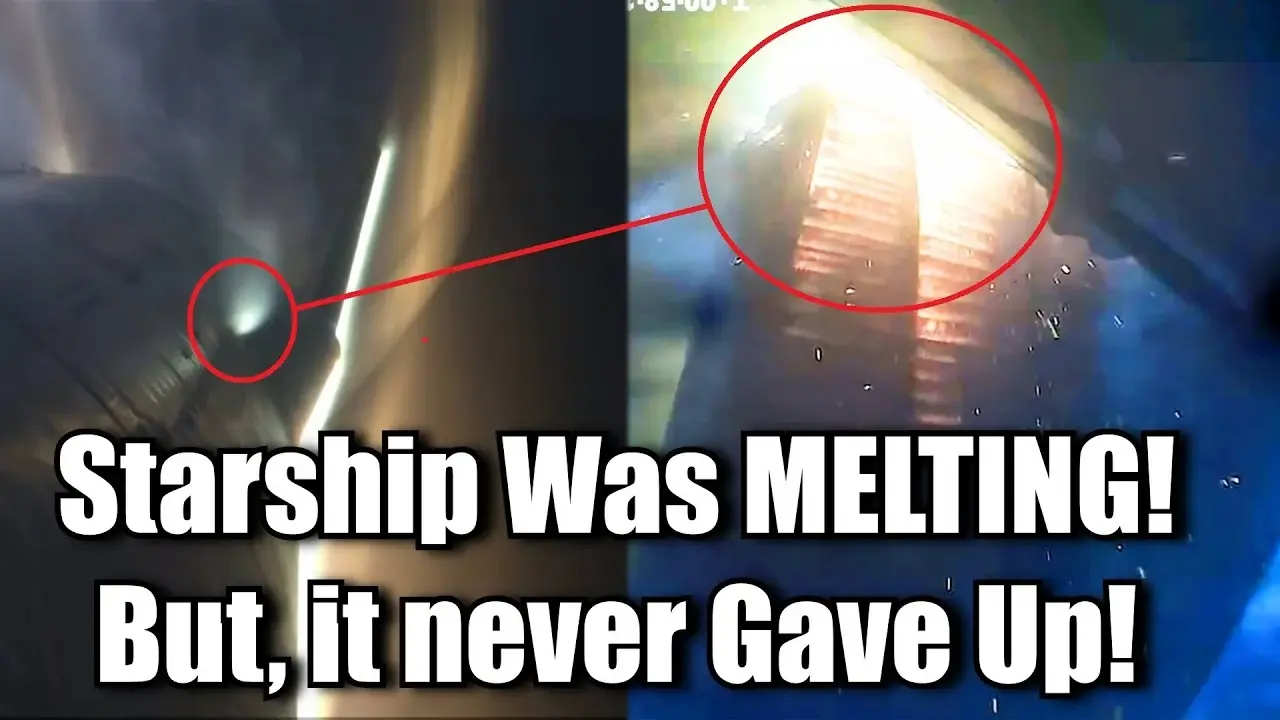Evidently the joints on the flaps still need a little work into not letting gases through, but it seemed to still have enough actuation to keep the spacecraft stable until the engines took over for the landing burn.

This really was awesome to watch live. Specifically I remember the part where the camera was almost completely covered, and the fin was barely visible. But juuuuuust barely, you could see that the fin was actuating, and it was alive! And then the crowd gets hype. That was the moment where I was like, wait, this could still happen!

The live was such a rollercoaster of emotions.
The moment the fin started to melt I thought this was the end of it, but it still hold on, and hold on. Then the image disappeared do I though that was it, but no it continued after that, we get the image back.
I start to think that it might be able to crash on water, maybe not in one piece but it would be a big improvement comparef to the last launch, especially since they already soft landed the booster.
And then it get a few km away from water level and at the last minute it DOES THE BELLY FLOP AND SOFT LAND ON WATER !
I had absolutely zero hope of that happening !

I thought for sure the camera was toast when it went all purple, it looks like the lense was essentially gone and we are just seeing the raw output of the CCD but then the flap moved and there was a few frames where you could actually see the flap and the damage but it’s still actuating!
Amazing engineering.
There is essentially no better data that this regarding what the error tolerance is on the flaps. Should help create lots if reliability in future versions

Honestly, I started laughing my head off when I saw that ragged flap still moving and the Starship still maintaining attitude control with it. That’s the sort of battle damage I expect to see in a science fiction show, I wasn’t expecting SpaceX to bring that sort of thing into the real world too.

Spacex livestream archived here: https://www.youtube.com/live/2G-L0u_L0qU

It’s not really ‘reusable’ like this though :) But this is how SpaceX iterate of course. I’m sure they’ll learn from this and fix it for next time.

I know I’m going to be bludgeoned for this. But I’m mystified by this ‘iterative’ approach to development. I wonder if they got this from the IT industry. Charles Bolden once remarked that the congress would have shut down the Apollo program if they lost vehicles at the rate spacex does now. These failures also often feel like the result of lack of foresight and critical thinking, rather than the consequence of complex chains of events that are hard to predict.
Consider the first flight. They decided to launch it without a flame deflector or a deluge system. They thought that it would be OK based on a hot test of the superheavy at half thrust. I don’t think any other rocket company would have made the same decision. Even if the concrete slabs didn’t shatter into a thousand pieces, the reflected shock wave would have been damaging enough to the engine compartment. They predictably lifted off with several failed and failing engines.
Another problem was the stage separation maneuver. They had planned on a full 360 degree cart wheel to separate the upper stage with centrifugal force. Not only was it going to cause enormous lateral and bending loads on the two stages, I’m still confused about how they would separate at all when the airflow is pushing the top stage (whichever happens to be on the top) against the bottom one. Perhaps the sideways loads might snap the joint. But the two stages are still in danger of collision due to airflow. This concern was proven to be valid when that flight cartwheeled several times without separating and then buckled. I don’t know if that’s the reason why they abandoned the maneuver, but something was definitely wrong with it. And it was bad enough to switch to hot staging.
I don’t have many comments about the second flight. Both stages failed in flight. The first stage failed due to problems with filters. I’m willing to give them a pass here.
As for the third flight, the superheavy exploded 400m above the seas. It was clear that it didn’t decelerate enough due to engine failures. More engine problems. But a pass here too, since engines are generally hard and the raptor is particularly nasty at that.
The real problem in that flight was the starship. It was tumbling pretty badly even in space. The video didn’t give any clue about how they could arrest the tumbling. I was looking for the operation of attitude/RCS thrusters and I couldn’t find any solid evidence of any of it. It was more like the starship had no attitude control at all, rather than one failing. Perhaps I’m completely wrong and it had attitude thrusters. But it was clearly deficient at least. The commentators of flight 4 said that they added more thrusters for attitude control. That would mean that either they didn’t consider tumbling as a problem or they completely underestimated it for flight 3. Why? Attitude control isn’t the hardest problem in rocketry. Very good simulation and analysis techniques exist for it. Anyway, a sideways reentry is bad enough. Even worse is an unarrested attitude rate at reentry. The atmosphere predictably incinerated the ship’s engines and exposed steel skin.
If this afterthought feels like a conspiracy theory, remember the time when Musk made a change to starship after Tim Dodd (earlyastronaut) asked him a question on the same? Or the time when someone on Twitter asked Musk why they didn’t start two raptor engines and then shutoff the underperforming one during Starship’s flip maneuver at landing? They do this now. Afterthoughts are evidently not a rare thing at SpaceX.
And finally flight 4. I’m not taking any credit away from them. They seem to have just made it till the landing. Superheavy worked all the way for the first time. But my concern is about the place where the starship’s fin burned through - exactly at the hinge. I would have expected them to focus more on that region as a weak spot and to have given it a better thermal protection. That would be the last region I would expect a burn through. Instead, it would have been in some spot where they didn’t expect any problem and missed something very subtle.
All these give me the impression that they are trying things and seeing what sticks. That’s not how traditional rocketry works. There’s a s**t load of analyses, simulations and small scale tests that precede the production stage. The result is that when such rockets fail, they fail in a spectacularly complex, unpredictable and mind bending sequence of cascading failures (unlike what I see on starship). They also tend to succeed with minimum test flights and work reliably over decades. Apollo is a great example. The first test flight achieved everything that starship achieved in 4 flights.
The only other industry that I’ve seen behaving like this is the IT industry. “Deploy whatever you have and we’ll debug in production”. Coincidentally, Tesla does the same with their cars - the only car company to do so. So perhaps there is a Musk factor here. The SpaceX engineering team is incredibly talented, skilled and capable. The only reason I can think of for them to behave like this is an enormous pressure on them to deliver results at high rates. That’s the only reason I can think of for them to proceed without satisfying themselves.
Now you may want to argue that SpaceX’s approach is better than what everyone else does. After all, they make bigger things, faster. They advanced the industry like no one else did or could. Perhaps you’re right. Only time will tell, since this approach is so novel that we haven’t had enough opportunity to assess the results. But my instincts worry me about one thing - technical debt. Mechanical engineering is not like software engineering. In software, a problem once solved is gone forever. In mechanical engineering, any problem you work around is a disaster waiting to happen in the future. The right approach here is to design things properly and meticulously so that the final product has minimum work around. I fear that the software style of design is leaving unknown flaws or technical debts that may compound together into a cascading failure on some flight in the future.
To those who are planning to reply:
What I wrote is not a criticism of the SpaceX employees or Starship programme. I’m genuinely fascinated by the interplay of technical design, development styles, management styles and human factors. I’m extremely curious about how the situation is evolving.
Please don’t attack me or question my abilities if you feel that I’m being unfair about this (that’s definitely not my intention). I may be just a kid in this arena, but it’s never wrong to ask, is it? I’m extremely interested in hearing your insightful opinion on this topic, based on your experience or your logic. If you think I’m wrong on any of these, please share your perspective and reasons here - I (and possibly others) may learn something new.

Charles Bolden once remarked that the congress would have shut down the Apollo program if they lost vehicles at the rate spacex does now.
Well, yes. But it was really a show of force towards the soviets and anything that could be construed as ‘failure’ would be sensitive. And it was all public money so things were very political and optics mattered. Society was also hugely different in the 60s.
Also in the years before mercury a lot of stuff went boom, of course. Apollo was built upon those failures.
I have a feeling that for SpaceX the opposite is true. Every time they shoot something up it’s press coverage, even if it blows up. As long as they’re not blowing up people they don’t get the boeing effect.
Consider the first flight. They decided to launch it without a flame deflector or a deluge system. They thought that it would be OK based on a hot test of the superheavy at half thrust. I don’t think any other rocket company would have made the same decision. Even if the concrete slabs didn’t shatter into a thousand pieces, the reflected shock wave would have been damaging enough to the engine compartment. They predictably lifted off with several failed and failing engines.
Yeah that was indeed very stupid. Agreed. Especially for the environment. They were right to get flak for that.
If this afterthought feels like a conspiracy theory, remember the time when Musk made a change to starship after Tim Dodd (earlyastronaut) asked him a question on the same? Or the time when someone on Twitter asked Musk why they didn’t start two raptor engines and then shutoff the underperforming one during Starship’s flip maneuver at landing? They do this now. Afterthoughts are evidently not a rare thing at SpaceX.
Could be yes… But don’t forget, it is their money. They’re clearly rushing to market and cutting corners, but as long as they don’t blow up people or property, it’s kinda their problem. And it has worked for them with Falcon 9.
I do agree they are kinda cowboys but they do also have a point in some ways: Field testing is better than theory. I’d rather step into a rocket that has flown 30 times than one that has never flown before but a whole team of scientists think things will be fine.
But yeah you still need theory and they could do a better job at that, I do agree there.

I think the biggest thing you’re not taking into account is the amount hardware they have compared to anyone else.
Of course Apollo would be shut down if they were loosing Saturn Vs left and right. Each of those is 1.2 billion in 2019 dollars and they launched 13 of them I’m total. They are way to valuable.
The total estimate cost to date for the entire starship program is 5 billion and they have built around 30 starships. They already have another one ready to go now, only reason to not launch right away is because it needs upgrades based on the data they just collected.
You’re also assuming that with more time and analysis they could predict things they have just discovered from a real launch. No man made object of this size has ever made a controlled entry back to earth. Not by a long shot.
Closest is space shuttle which had lots of issues that couldn’t be fixed because each launch was so expensive it had to carry real payload (and people) and changes to human flight hardware is near impossible.
The main thing that’s different here is that the cost of a launch is way less than the cost of a year of lab testing and still not knowing the answer because it’s never been done before. That’s the hardest paradigm shift to accept and is true only of SpaceX and no one else right now until they go full force into reusable rockets.

It is estimated that currently each starship launch is cost around $90 million, and should be around $10 million once the program is more mature.
For comparison each SLS launch is estimated to be around $4.1 billions. This cost not include development.
So a Starship launch is around 40 to 400 time cheaper than the SLS for similar capacity in LEO.

The Apollo compairaon above is even more ridiculous when you consider that starship made it to orbit and could’ve deployed a payload. The part that ‘failed’ was the soft landing and even that didn’t fail. Only reuse failed.
Every Saturn v that was launched is currently sitting at the bottom of the ocean.
Taking shots at starship for failing even though Saturn v didn’t even attempt the same mission parameters makes no sense.
Starship will have likely had 100+ missions before putting a human on it. Would you rather fly on something that’s proven itself 100 times or something that is flying for the first time?

Simple explanation: 21st century tech.
A palm sized quadcopter, has more sensors and processing power, than many 20th century rockets.
SpaceX can afford to build dozens of (relatively) cheap prototypes, fill them with all kinds of sensors, hook them up to StarLink, and gather massive amounts of real-world data instead of some make-believe simulations, even when the rocket turns into thin dust. No video or flight recorders required.
For this latest flight 4, keep in mind that the damage to the flap would have thrown any simulation-based and verified flight computer program into the ground… but whatever they used, managed to adapt, compensate, and essentially land a rocket that was falling apart… all the while streaming live video and telemetry.
In software, a problem once solved is gone forever
That is not correct, and why having tests to detect regressions is important.
Not sure how much “technical debt” SpaceX might be incurring, but my guess is that each of these flights is providing massive amounts of data to plug into simulations of future designs, which might be more valuable than having a single “meticulous design” that would fail spectacularly if something like a rubber seal were to get too cold the night before.

Congress would definitely have shut down NASA if they’d have that many failures which is why they never did it like this but that doesn’t necessarily mean that doing it like this is a bad way of doing it.
NASA did do some testing but they never did integrated testing. Who knows, if they done integrated testing then perhaps Apollo 1 would have just been a test and no one would have died. Had they filled the crew capsule with the air mixture and had some device simulating human movement maybe they would have realized that static electricity was a problem. You can’t simulate absolutely everything and if you do go with simulations at some point you have to test your assumptions in the real world.
NASA didn’t do this for political reasons, not engineering ones.

This process led to Falcon, which is one of the most reliable rockets of all time. The launch rate and reuse are unprecedented. Iterative design is a big part of how they got there. Their prowess in manufacturing and mass production is another large part of that success.

Well it was landing in the ocean so it was never going to be reusable.

They do refurbish stuff that’s dunking in the ocean though, like the fairings (which do also contain active parts).
Also the dragon spacecraft. It lands in the sea and gets reused.

Yeah but these ones were never designed to survive. I get what you’re saying but no one wanted these to be long lasting there was no effort to make them survive
I don’t actually think they do design this stuff to survive salt water. They don’t really care, since they’re prototypes. In the long run they’ll design them to survive ocean impact, but these ones, no. They were never expected to survive.

These are prototype rockets. They iterate so fast the they already have new designs that make this one obsolete. It’s purpose was to gather data on the various things including heat tile performance so they know what to upgrade next.
The next one that flies will also be obsolete with a newer one already partially completed.


